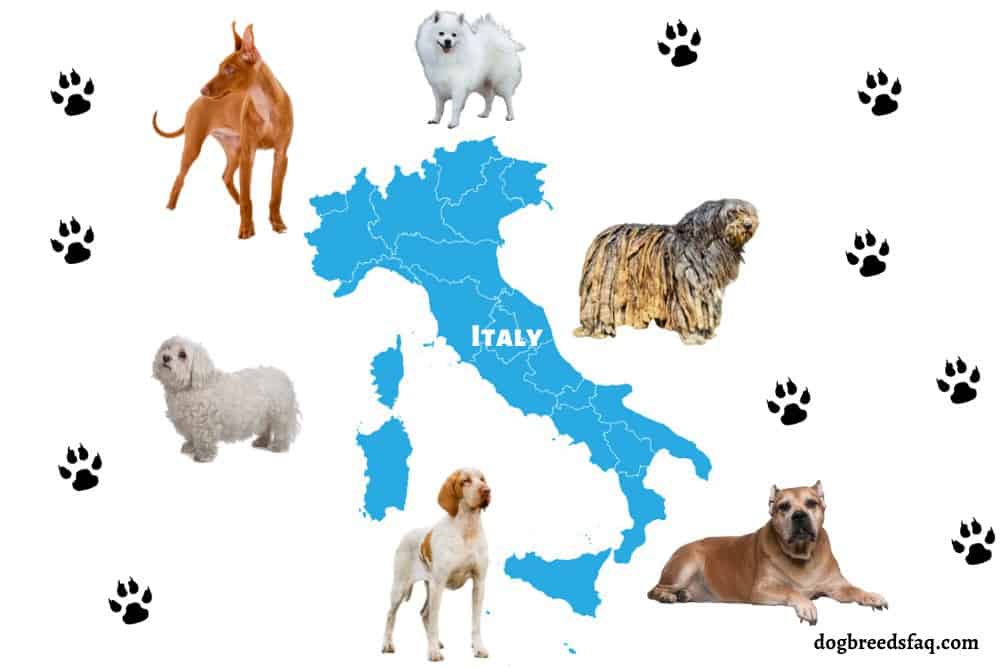Italy is known for many things: amazing food, wine, and culture.
Italy is also widely known for producing many famous dog breeds that are owned across the world.
While some might be rarer than others, many Italian dog breeds are easily recognizable, even if you don’t know their names.
Each breed has something unique and exciting to offer, so check out this list of the top 13 Italian dogs.
1. PASTORE BERGAMASCO (Bergamasco Shepherd)

Highlights: Patient, Loyal, Smart
Although not many people might know the name Bergamasco Shepherd, a.k.a. Bergamasco Sheepdog most will probably be familiar with the breed’s appearance.
The breed is known for its unique appearance, as its coat develops into dreadlocks. This is completely normal for the breed and is one of its selling points.
The Bergamasco Shepherd was originally used as a herding dog near the town of Bergamo, which is in the Italian Alps.
The breed’s coat was developed to help protect the dog against the harsh weather of the Alps, while also protecting it from predators.
The breed is medium-sized, and will generally stand between 22 and 24 inches high, which isn’t far off a breed such as the Golden Retriever.
The Bergamasco Shepherd has quite a stocky body, which also helped to keep it warm in cold weather.
The coat is the breed’s distinguishing feature, and it’s made of 3 different kinds of hairs.
The bottom layer is an oily undercoat that prevents it from getting wet, the middle layer is coarse and harsh, and the top layer is woolly or fluffy.
As the dog gets older, the layers mat together to form flocks.
Did You Know?
- The Bergamasco Shepherd doesn’t shed its fur, so it is considered a hypoallergenic breed.
- This Italian dog breed has very long eyelashes to keep fur out of its eyes. Its long fringe is to protect against snow blindness.
- The Bergamasco Shepherd can trace its origins back 7,000 years to present-day Iran, where its ancestors were used as the first herding animals.
- They nearly went extinct after WW2. Thanks to Italian Breeder Dr.Maria Andreoli, who led a movement to save the Bergamasco.
Temperament

The Bergamasco Shepherd is an intelligent and alert breed that’s also known to be very patient and good-natured.
Similarly, their use as a herding breed means the dogs have excellent self-discipline, but this obviously responds best to training.
The breed is also known to be great around children and forms a strong emotional bond with its owners.
Bergamasco Shepherds are also known for not being aggressive, and any sign of aggressive behavior is considered a breed fault.
Even though the breed isn’t aggressive, their herding traits make them surprisingly good guard dogs.
They’ll bark when alerted but won’t be aggressive towards any intruders. However, their size and appearance make them potentially quite intimidating, which can be a big help in this situation.
Generally, the Bergamasco Shepherd is known for its intelligence and potential for independence.
Like other clever dogs, they require lots of mental and physical stimulation to prevent boredom and depression.
However, if cared for properly, a Bergamasco Terrier can be an amazing family and companion pet.
Feeling Adventurous?
Browse dogs from Other European Countries below:
[table id=50 /]Related Questions:
1. Do Bergamasco shed?
The Bergamasco Shepherd is one of the Italian dog breeds that don’t shed in the traditional sense that it replaces its coat seasonally. Its coat mats together into flocks, but it still loses individual hairs once they reach the end of their lifecycle.
2. How much is a Bergamasco puppy?
Bergamasco puppies aren’t particularly common outside of Italy, but breeders do exist. If you were thinking of adopting a Bergamasco puppy, they cost 1000-1200 USD.
2. BOLOGNESE DOG
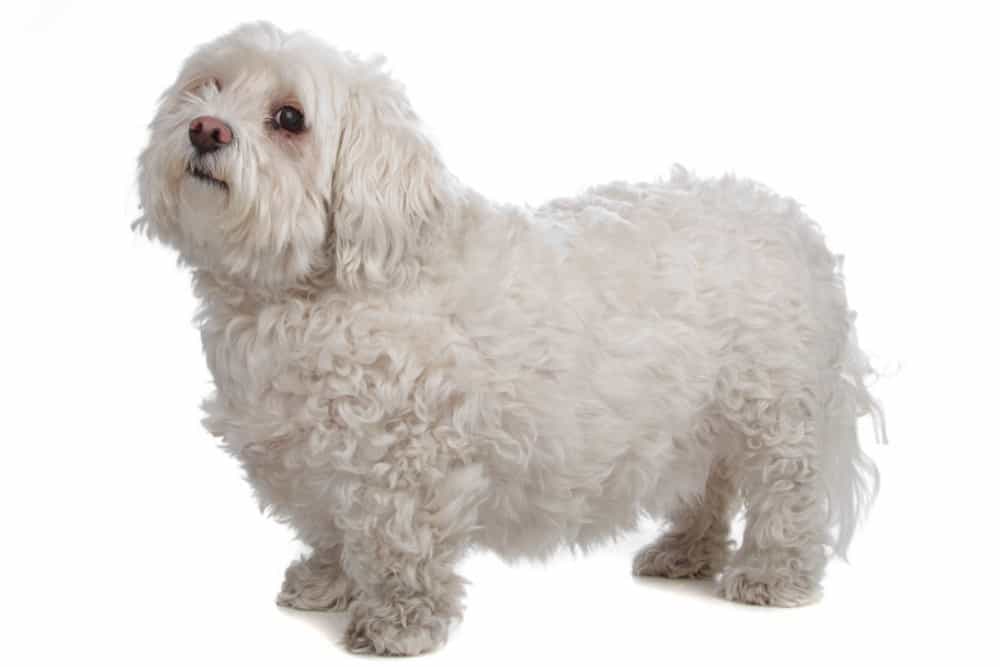
Highlights: Affectionate, Playful, Friendly
The Bolognese dog, unfortunately, has little to do with the pasta sauce, other than they both originate from the same area, Bologna.
The Bolognese dog is a member of the Bichon family, which is a well-known and easily recognizable type of toy dog in the Western world.
The breed is known to be a great companion dog, and this is exactly what it was originally bred for.
Like other Bichon breeds, the Bolognese dog was created as a companion pet for the upper classes in Italian society, particularly the aristocracy.
The first examples of the breed were recorded in the early 13th century, which makes this a very ancient breed.
Like other dogs in the Bichon category, the Bolognese dog has a white coat that ranges between fluffy and curly.
It’s a small Italian dog breed with a single-layer coat. While Bolognese dogs are often included in lists of hypoallergenic breeds, it’s actually that they don’t experience seasonal molts, but aren’t hypoallergenic.
Although generally easy to care for, Bolognese dogs do require daily grooming to remain looking their best.
Did You Know?
- Bolognese dogs featured heavily in European art. One of the best examples is from a painting by Titian, which was painted in 1477.
- The breed became very popular with European royalty after eight puppies were given to the Belgian royal family in 1668.
- The average lifespan of a Bolognese dog is 14 years, and they’re known to keep their puppy-like personality for most of their life.
Temperament

Bolognese dogs are very friendly and make great companion pets. Their most popular demographics are the elderly and families, which is mainly because the breed is quite easy to care for.
However, families with very young children should be wary because small dogs aren’t as hardy as bigger dogs.
The breed, like its relative, the Bichon Frise, is known for being very playful and eager to please, along with being very loyal to their owners.
Bolognese dogs make great alert dogs because they’re aware of what is happening around their home, but they won’t do more than barking. However, they’re not known to be obsessive barkers.
Bolognese dogs generally get on well with other dogs and will warm to strangers if their owner introduces them.
However, potential owners should be aware of the breed’s need for attention, and that they shouldn’t be left alone for too long because they can become very anxious.
[table id=51 /]Related Questions:
1. Do Bolognese dogs bark a lot?
Bolognese dogs do bark, but no more than any other breed. However, if they will bark more if they feel anxious or threatened or are left alone for too long. Bolognese dogs need plenty of human attention.
2. How much is a Bolognese dog?
Bolognese dogs are rarer than other Bichon types, and so are more expensive. You can expect to pay anywhere between 1,500 and 2,500 USD from a reputable breeder.
3. Do Bolognese dogs bite?
Bolognese dogs are known to have a higher chance of biting than other breeds. However, this is often if they feel threatened or anxious, as they’re not an aggressive breed by nature.
3. CIRNECO DELL’ ETNA (Cirneco of Etna)
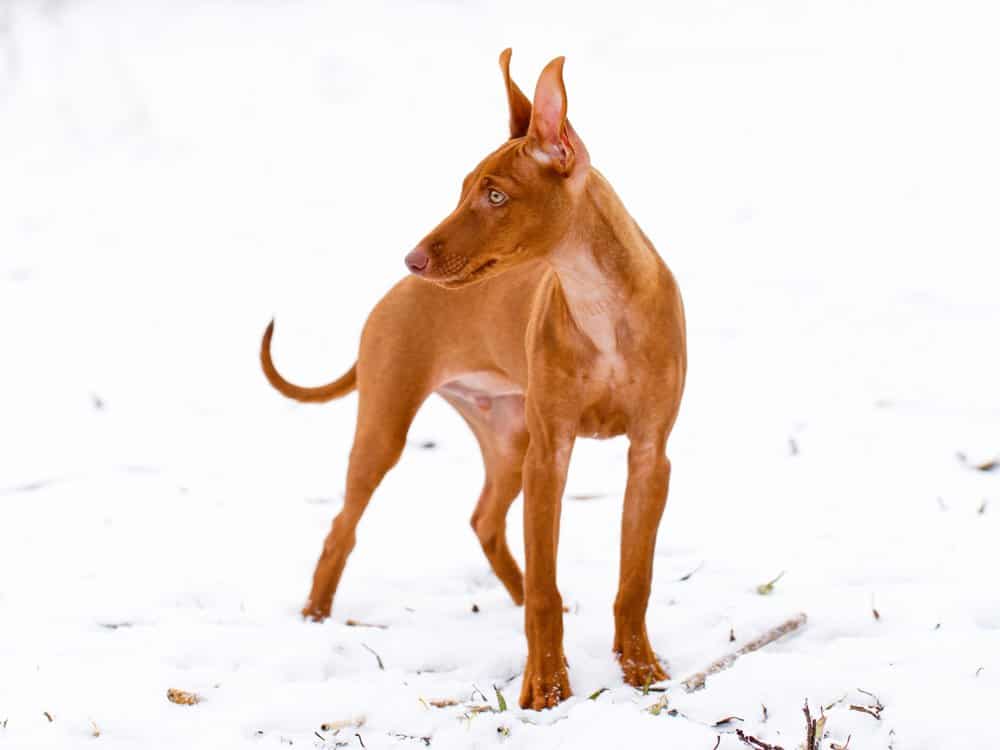
Highlights: Alert, Intelligent, Active
The Cirneco dell’ Etna is a small breed of dog that was originally used for hunting rabbits on the Italian island of Sicily.
Their small size and slight build make them ideal for getting down rabbit holes, and this made them a popular working breed on the island of Sicily.
One of the most interesting things about the Cirneco of Etna is that it can go for hours without food and water.
While the food part might not be that surprising, the breed can last an incredibly long time without water, which is relatively impressive.
This is because the breed was used for hunting rabbits on Mount Etna, which is notorious for being harsh and almost desert-like terrain.
The Cirneco of Etna was developed with the sole purpose of endurance working in harsh terrain, and it’s perfectly suited for this.
Not much is known about this dog outside of Italy, and even there, it’s not a particularly well-known breed.
It’s generally still only used for hunting, but the breed is taking off in dog shows and agility competitions, although this is still relatively new.
Generally, a Cirneco of Etna will stand between 18 and 20 inches in height, but this is the breed standard established for shows.
Those still used for hunting aren’t bred to such strict standards, and so will likely fall outside of this size range. After all, the smaller ones will usually have an easier time hunting rabbits.
Did You Know?
- The breed gets its name from Mount Etna, an inactive volcano on Sicily. This is where the dogs were used for hunting rabbits.
- Cirneco dell’ Etna were rabbit hunting specialists and were used alongside ferrets. The dog would locate the rabbit, and the ferret would be sent in to flush them out for the dog to kill.
- They were depicted on several different coins minted in Sicily in the 5th century BC, which shows how popular the breed was.
Temperament
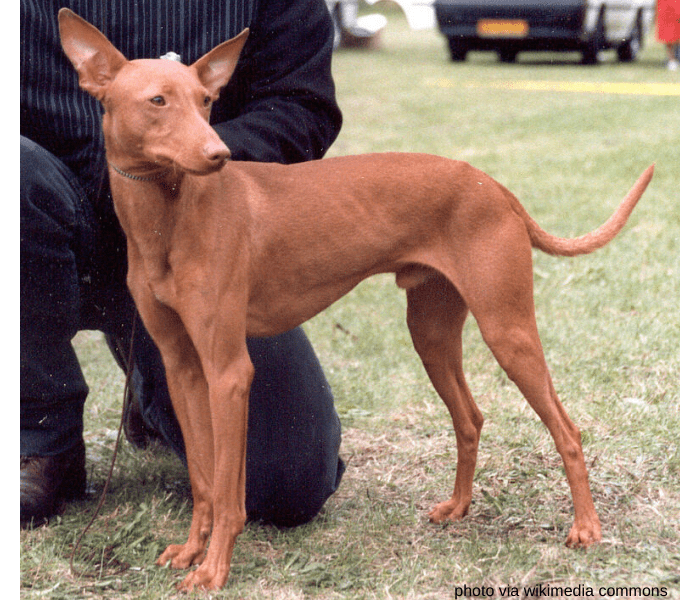 The Cirneco dell’ Etna is known for being a relatively easy-going dog breed that’s alert and intelligent.
The Cirneco dell’ Etna is known for being a relatively easy-going dog breed that’s alert and intelligent.
The breed’s working purpose requires it to have intelligence and independence, which makes these very interesting dogs to own.
This also means that owners have to put in plenty of effort, keeping them entertained.
As you can probably imagine, the breed is very active and loves exercise. Its built-in endurance means that the Cirneco needs much more exercise than you might think for such a small dog.
The breed will generally require at least an hour of exercise every day, but more would be better.
Although the Cirneco’s relationship with children isn’t well documented, there’s no reason why they wouldn’t be a good choice as a family pet.
Their easy-going nature makes them tolerant of children and patient of family life, but this is only if they get enough mental and physical stimulation. A bored Cirneco will become a destructive Cirneco.
[table id=52 /]4. CANE CORSO (Courser)

Highlights: Strong, Loyal, Curious
The Cano Corso is a large Italian breed of dog that originated in southern Italy, where it’s still used as a protection dog.
The breed shares many similarities with other large European dog breeds, including its muscly physique and intimidating strength. That said, it’s more slight of the body than other Mastiff breeds.
The Cane Corso descends from the ancient Molosser dogs, which were used in war.
The name translates to “dog” from the Italian “cane” and “courtyard” from the Latin “Corso”.
As you can probably tell from the name, the primary purpose of this breed was as a guardian animal for people’s homes and property.
The breed became much rarer in the 20th century when changes in Italian farming practices mostly removed the need for its presence.
While it nearly became extinct by the 1970s, a group of breeders got together to save the Cane de Corso, which is now an internationally recognized breed.
It’s still mostly used as a protection and guard dog, although the Cane de Corso is also used by Italian police forces too.
In the police, the breed is used for tracking, protection and searching, as it has a surprisingly good sense of smell.
Also, its size is very intimidating, which is why it’s so effective as a guarding breed.
Did You Know?
- Until about 30 years ago, the Cane Corso was essentially unknown outside of southern Italy and is still considered very rare.
- The breed’s short, coarse coat is designed to keep it waterproof.
- When Corsi were used in war, they would have a bucket of flaming oil strapped to their backs and would then be sent charging at the enemy.
- Cane Corso dogs drool, snores and have a throaty “woo-woo” bark.
- Cane Corso ear cropping is a popular practice for some dog owners
Temperament

The Cane de Corso is surprisingly gentle and friendly when it comes to its owners, but is also very wary of strangers.
However, if introduced under the right conditions, the Cane quickly warms up to new people. The same is true of other dogs, but proper training is a must.
When it comes to training, the Cane do Corso is easy to train and learns commands pretty quickly.
Training is so much more important with big dogs than it is with small, as proper training is the only thing keeping a big dog under control. Mastiffs like the Cane are known primarily for their strength, after all.
The Cane de Corso might not be suitable for all owners, but they definitely make a great companion pet if you have the confidence to own one.
The breed is known to form strong attachments to its owners and is very loving and tolerant of children.
[table id=53 /]*Cane Corso median age at death (years)[1] : 9.25(male), 9.33(female)
Related Questions:
1. Are Cane Corso dogs dangerous?
Cane Corso dogs aren’t dangerous or aggressive by nature but can be difficult to control. Owners need to be confident in their ability, as an unruly Cane Corso could be dangerous if not handled properly.
2. Is a Cane Corso right for me?
A Cane Corso isn’t a typical family dog, both due to its size and rarity. Only consider a large dog if you have the space to keep it and the confidence to handle it properly.
3. Are Cane Corso good around kids?
Cane Corso are known to be patient and friendly with their families and are particularly tolerant of kids.
They’re known to play with kids and so can make a good family dog in the right situation.
5. BRACCO ITALIANO (Italian Pointer)

Highlights: Playful, Loyal, Stubborn
The Italian Pointer, much like its other European cousins, was bred as a gun dog that filled a variety of roles.
The main one was chasing and scenting prey, but it was also used for fetching prey too.
However, Italian Pointers have also become very popular as a family pet in recent years.
This makes them similar in size to other Pointers, as are they in appearance. However, Italian Pointers have a vastly different temperament to the other breeds.
Traditionally, Italian Pointers had their tail docked because it was believed this would reduce their chance of injury while working.
However, there’s been a shift away from this in recent years, and many working Pointers now have full tails instead.
The Italian Pointer includes two different varieties of the breed, which both originated in different parts of Italy.
The significant difference between them is size, as one was used for hunting in the mountains and so was better suited to being smaller and more agile.
While the Italian Pointer was well in use by the Middle Ages, it became popular with Italian aristocracy in the 18th and early 19th centuries, when it was used for hunting birds. By the end of the 19th century, however, it had become nearly extinct.
It was only saved by a small handful of Italian breeders who worked hard to locate the last specimens. The breed standard was created in 1949, and this is now used across the world.
The standard defines Italian Pointers as having a short, dense coat that’s white with amber or chestnut markings.
This is similar to other Pointer breeds, as the Italian Pointer shares many of the same physical characteristics.
Did You Know?
- Ancestors of the Italian Pointer can be found in art and writing dating back to the 5th century BC.
- The breed was particularly loved by the Medici family. Dogs bred in their kennels were sold to European royalty.
- The Bracco Italiano is a very strong swimmer and loves to be in the water.
Temperament

Italian Pointers love human attention and go out of their way to please their owners.
They make great family pets but should be appropriately trained before introducing them to children.
While the breed isn’t known to be aggressive, their size and weight means they can do some damage, even accidentally.
The breed is known to get along fine with other dogs, but again training is vital.
After all, the breed was used for hunting and so retains a relatively strong prey drive.
While they won’t necessarily use this on other dogs, they are known to chase.
Italian Pointers are known for their intelligence, which can make them difficult to control.
However, with plenty of exercises and mental stimulation, an Italian Pointer will make a great family pet.
[table id=60 /]Related Questions:
1. Does Bracco Italiano shed?
The Bracco Italiano does shed, but not as much as some other breeds. Their short coat is particularly easy to care for, though, and weekly grooming will minimize shedding.
2. How much do Bracco Italiano puppies cost?
Bracco Italiano puppies are considered quite rare, which makes them quite expensive. You can expect to pay anywhere up to 3000 USD for a Bracco Italiano puppy.
6. SPINONE ITALIANO (Italian Spinone)
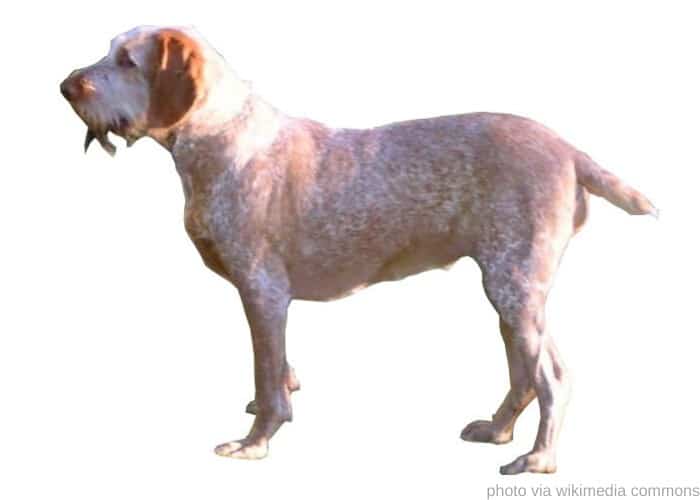
Highlights: Patient, Considerate, Active
The Italian Spinone is another breed of gun dog that originated in Italy.
It’s probably one of the most ancient breeds found in the country, as it can trace its lineage back to 500BC. As far as experts can tell, it’s hardly changed in all that time.
The breed is believed to come from the Piedmont region of Italy, although not much is known about its original purpose.
While it’s used as a modern gun dog, this obviously wouldn’t have been its purpose back then. Most believe it was used as a pointer and prey retrieval dog.
Like many other breeds, the Spinone nearly became extinct during World War 2.
This was not only because of the war but also because Italian hunters began using imported hunting breeds, such as setters and pointers.
However, the breed has taken off again in recent years, both as a working and companion animal.
The Italian Spinone has a medium-length wiry coat that can come in several different colors.
However, the breed characteristically has much shorter hair around its eyes, nose, and mouth.
The breed standard state the dogs should be between 24 and 28 inches in height, and 75-85lbs in weight.
Did You Know?
- The Spinone Italiano is also known as the Italian Coarsehaired Pointer.
- Its Italian name, Spinone, refers to a bush called Pino. These thorny bushes were the type of terrain Spinone would be used to hunt in.
- The breed only has a single-layer coat but is protected from injury by extra thick skin.
Temperament
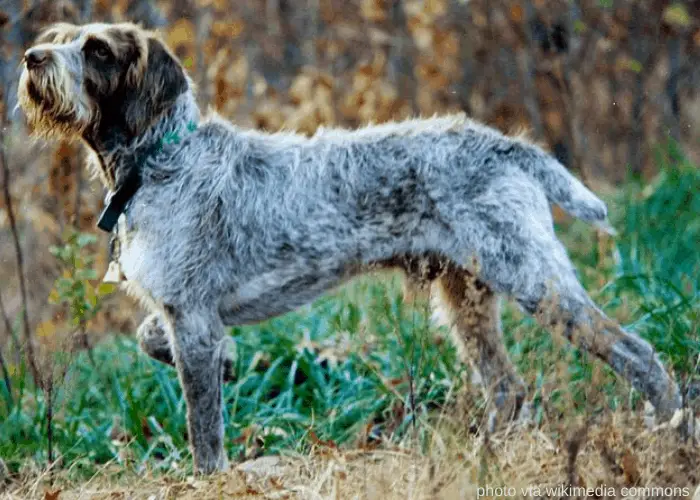
Although not necessarily related to its working purpose, the Italian Spinone is known for being an incredibly patient breed.
This makes it ideal to have around children because it can be very tolerant of their behavior. As ever, though, proper training is vital.
Spinone are very intelligent and loyal dogs, but much of this probably comes from the millennia of working with people.
The breed isn’t known to be aggressive with people or other animals but should be socialized from a young age to ensure success.
As with other hunting dogs, the Spinone is very active and so needs plenty of exercises.
Daily walking is a must, as is some land at home that it can enjoy. Similarly, mental stimulation is important to prevent the dog from becoming bored and destructive.
[table id=61 /]#idiopathic epilepsy[2]
Related Questions:
1. Does a Spinone Italiano shed?
Spinone Italiano are considered very messy dogs.
Like other shaggy dogs, they do shed, but not as much as a double-coated breed. Their coat is quite hard to brush because it’s naturally scraggly.
2. How much is a Spinone Italiano?
Spinone Italiano are another breed not really known outside of Italy. If you wanted to adopt one, you could expect to pay around 2000 USD for a good specimen.
3. How long does Italian Spinone live?
The Italian Spinone is a reasonably healthy breed with few health complications. This makes their average life expectancy for around 14 years.
7. CANE DI MANNARA (Sicilian Shepherd)

Highlights: Loyal, Protective, Intelligent
The Sicilian Shepherd is, as you can tell from the name, a breed of dog originating in Sicily that’s used for livestock herding.
The breed is both primitive and very rare and resembles a wolf more than it does other domesticated breeds.
In fact, as of 2012, there were only 90 of these dogs left in the whole world. A breeding program was set up in 2010 to save the breed from extinction.
Part of the work is getting it formally recognized by kennel clubs, as this will allow breeders to build stud books.
Evidence of the Sicilian Shepherd has been found all the way back to the Bronze Age, making it one of the most ancient breeds on this list.
As far as an expert can tell, the breed basically hasn’t changed in all that time.
Unlike other herding breeds, the Sicilian Shepherd is used for both herding and protection.
In fact, its name “mannara” refers to the thorny bushes used to enclose a herd of sheep in the field.
The dogs are believed to stay in these bushes rather than return home with the shepherd.
Not much is known about the breed outside of Sicily, but that’s something the Samannara Association is hoping to change with their breeding efforts.
Part of their conservation is education on the importance of this ancient breed.
Did You Know?
- The Sicilian Shepherd is considered one of the oldest Italian dog breeds.
- Similarly, it’s also one of the rarest breeds, both in Italy and the world.
- The breed’s studbook and the breed standard was only established in 2013, but this has helped the breed receive recognition.
- Cane di Mannara faces extinction and there were only 90 of them known to exist in 2012. (No available report in 2019)
Temperament
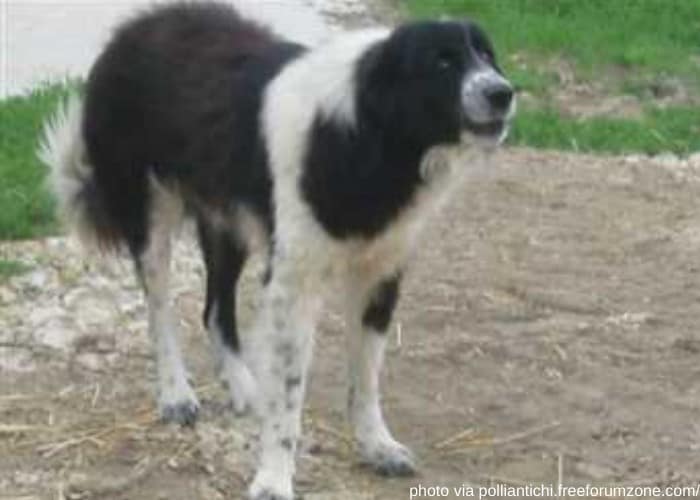
Not much can be said about the Sicilian Shepherd’s temperament because they’re basically non-existent outside of their working role.
However, their role requires them to be patient, intelligent, and independent, like many other herding breeds.
Sicilian Shepherds aren’t typically seen as a family pet breed, but there’s nothing to say they shouldn’t be (other than their rarity).
Their characteristics make them suitable as family pets and they’re likely very good with children.
Although the breed was very close to extinction when it was last counted, it’s hoped that conservation efforts will change this.
It’s also hoped that the breed will become more widely recognized outside of Sicily, as there’s no reason this shouldn’t become an incredibly popular breed.
8. SEGUGIO MAREMMANO (Maremma Scenthound)

Highlights: Alert, Playful, Smart
The Maremma Scenthound is a breed of hunting dog that originates from the area of Maremma, near Tuscany.
It’s used for hunting wild boar, and although some kennel clubs have recognized it, the appearance of working dogs varies massively.
Not much is known about the history of the breed, but that’s mostly because it’s used as a working breed and hasn’t been studied as much as other popular ones.
Similarly, this lack of history and study has meant there’s a great deal of variation in the breed’s appearance.
The Maremma Scenthound is recognized by the Italian Kennel Club, which states the dogs must stand between 18 and 21 inches in height, and should be black, brown, or brindle in color.
However, these breed standards are quite new and so haven’t been enforced in the working world yet. Similarly, working owners never care as much about breed standards.
One of the biggest positives of this fact is that the breed is relatively safe from genetic inbreeding.
Anyone familiar with pedigree dog breeds (King Charles Spaniels and Pugs are great examples) will know the problems that arise from selective breeding.
The sheer genetic variation in the Maremma Scenthound should avoid this problem though.
Did You Know?
- Although on the smaller side, a pack of Maremma Scenthounds has little problem taking down a wild boar.
- The breed comes in both shorthair and rough hair varieties, which look like two completely different breeds.
- Maremma Scenthounds are incredibly agile dogs with surprising strength.
Temperament
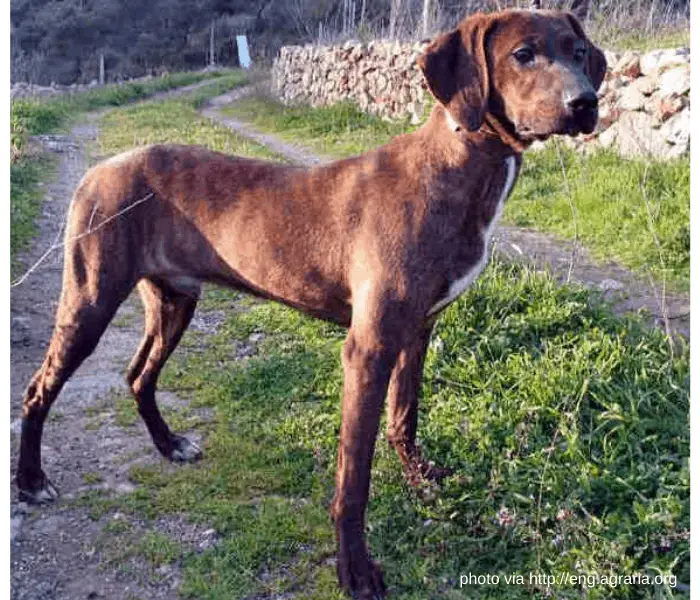
The Maremma Scenthound is a very intelligent breed that has amazing independence and problem-solving skills.
Dogs aren’t often thought of as problem-solving, but scent hounds need to be able to think quickly and overcome obstacles to perform their jobs.
Similarly, Maremma Scenthounds are very active dogs that can work for many hours without rest.
While this is an advantage in the working world, it can be a disadvantage in a domestic setting.
Anyone thinking of owning a Maremma Scenthound should be aware they need lots of exercises and mental stimulation.
The breed is also surprisingly good with children and they can be surprisingly tolerant.
Their intelligence means that training is generally easy, but also very important. Intelligent dogs can sometimes be disobedient just for the fun of it, so proper training is a must.
[table id=70 /]9. MASTINO NAPOLETANO (Neapolitan Mastiff)
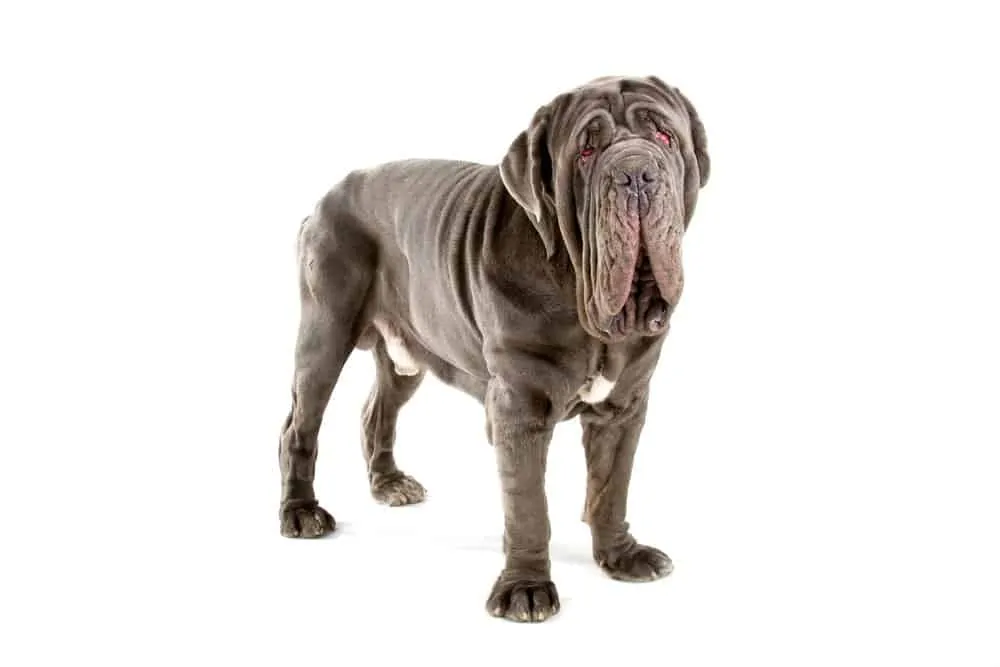
Highlights: Fearless, Obedient, Protective
The Neapolitan Mastiff is, unsurprisingly, a breed of Mastiff that comes from the Naples region of Italy.
It’s traditionally used for protection and guarding property, much like the Cane de Corso. In fact, the breeds are related, but it’s believed the Cane came first.
The breed can trace its lineage back thousands of years to the Molosser fighting dogs, but it wasn’t officially named as a breed until after the Second World War.
Before then, it was just seen as a working Mastiff and wasn’t named until it was first shown.
The Neapolitan Mastiff is a very large breed that can stand up to 31 inches in height and weigh up to 150lbs.
Like other Mastiff breeds, it has a wrinkly face with lots of extra skin. The breed also has loose skin around its stomach and legs, which was a form of protection against bites.
One of the best-known facts about this breed is their sheer strength.
Like other Mastiffs, the Neapolitan Mastiff is significantly stronger than a person, and many of the dogs aren’t aware of this fact when they’re young.
This means that owners need to be incredibly confident in their actions, as the only thing controlling the dog is respect.
Did You Know?
- The breed’s loose skin is a defense against attacks from other dogs.
- While not particularly aggressive dogs, Neapolitan Mastiffs are effective as property guardians simply because of their size.
- Ancestors of the Neapolitan Mastiff were used as gladiators by the ancient Romans, along with being property guardians.
Temperament

Neapolitan Mastiffs are incredibly loyal animals and love human companionship.
Generally speaking, the dogs would prefer to be with their families than anywhere else.
This is quite surprising for such big dogs, which are often considered more independent than smaller ones.
Similarly, Neapolitan Mastiffs are incredibly protective of their family and property.
Their main role for a very long time has been protection, so this is what they’re naturally inclined to do.
The breed is wary of strangers and will bark, but isn’t known to be physically aggressive. Often, their size is enough of a deterrent.
However, Neapolitan Mastiffs are also incredibly intelligent dogs, which isn’t always true of Mastiffs.
They can learn commands very quickly, and this should be used to the owner’s advantage because the dogs should be trained properly from a young age.
Providing they’re trained properly, Neapolitan Mastiffs are fine to have around children.
The biggest thing they need to be taught is how to be careful because the dogs are often not aware of their size and weight.
[table id=71 /]> entropion[3]
Related Questions:
1. What is the life expectancy of a Neapolitan Mastiff?
Like many other large breeds, Neapolitan Mastiffs have a relatively short life expectancy of 8-10 years. This is because they’re prone to many developmental and skeletal disorders.
2. How much does a Neapolitan Mastiff cost?
Neapolitan Mastiffs are relatively common outside of Italy. For this reason, you could adopt a puppy for 300-500 USD.
3. Is a Neapolitan Mastiff dangerous?
Despite its past, the Neapolitan Mastiff isn’t a dangerous breed is raised properly. They need plenty of training and socializing at a young age though.
10. VOLPINO ITALIANO (Italian Fox)
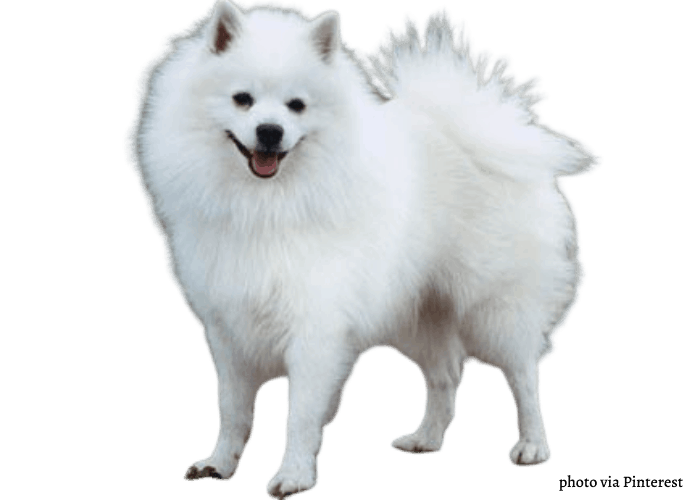
Highlights: Friendly, Energetic, Playful
The Italian fox is a small breed of companion dog that originates in Italy.
Its name literally translates as “small Italian fox”, which is accurate for both its size and appearance.
Although not many would think it looks like a fox, this was an accurate name back in the early 20th century.
Examples of the Italian fox have been found in peat bogs dating back to 4000BC, when the breed was still kept as a companion dog.
Experts have decided this based on the fact that the dogs were found wearing jewelry, often made from ivory.
As with many other companion breeds, the Italian fox features heavily in Italian art, and it can be seen in paintings dating from the 16th century.
Similarly, Queen Victoria was a fan of the breed, and she owned several of them in her lifetime. She first discovered them on a trip to Florence.
The Volpino has also been a popular dog with Italian royalty for centuries but was largely unknown outside of Italy until the late 19th century.
Along with being a companion dog, the Volpino was also used as an alert dog, which is something it’s still very good at.
The Italian fox is a small Italian dog breed that’s very similar in appearance to the Pomeranian.
It has a medium-length fluffy coat that has to be white by breed standards. While the dogs take very little upkeep, their coat needs regular grooming and maintenance to look its best.
Did You Know?
- Queen Victoria had several Volpino Italiano. Their names were Red Fluffy, White Turi, Gina, Lenda, Lela, and Bippo.
- Examples of art displaying the breed are found dating back to the 16th century and are on display in the British Museum.
- The Volpino Italiano is one of the Pomeranian’s founding breeds.
Temperament

The Italian fox is a relatively active and energetic breed, especially considering its size.
While not known for its intelligence, the breed can pick up training quite quickly and can be very independent.
Also, the breed is known for being very affectionate towards its owners and will form strong emotional bonds with the family.
They’re very good around children, but owners should be cautious, keeping them around very small children.
This is more for the dog’s benefit, as their size makes them susceptible to injury.
As mentioned, Volpinos make very good guard dogs because they’re wary of strangers and will bark if alerted.
However, training is helpful, as not all owners want their dogs to be wary of strangers.
Volpinos will be fine around other dogs and people, providing they’re introduced with their owner.
[table id=72 /]Related Questions:
1. Are Volpino Italianos hypoallergenic?
Yes, they are hypoallergenic.
11. ITALIAN GREYHOUND (Piccolo Levriero Italiano)

Highlights: Timid, Active, Curious
The Italian Greyhound, nicknamed “IG” or “Iggy” is one of the smallest breeds of sighthound in the world, and it was this size that made it so popular as a companion pet during its early history.
Along with companionship, the Italian Greyhound was also used in hunting, although this became its secondary purpose.
The breed was incredibly popular in the 16th century because there was a great demand for tiny dogs.
Some breeders attempted to make it even smaller, but this often ended in horrific genetic defects, so efforts were stopped.
Due to this intervention, the breed almost died out. However, by the 17th century, it had been returned to its original state, and this is when it was introduced to England.
The Italian Greyhound is seen as the original Greyhound, and it’s from this that other breeds arose.
As with other popular companion dogs, the Italian Greyhound can be seen in lots of art from this period.
Similarly, the breed was very popular with royalty, including Catherine the Great and Queen Victoria.
The breed has remained largely unchanged since the 17th century, although selective breeding has led to some health problems.
Included in these are things like cataracts and leg breaks, which are a symptom of the breed’s incredibly skinny frame.
As a result, the breed has an average lifespan of 9 years, which is very low for a small breed.
Much of this is down to the number of illnesses found in the breed, as very few Italian Greyhounds simply die of old age.
Did You Know?
- The Italian Greyhound is the smallest of all Greyhound breeds.
- Italian Greyhounds were painted by a number of Renaissance artists, including Giotto, Van der Weyden and Carpaccio.
- The World Wars nearly destroyed the breed, but several American breeders saved it.
Temperament

The Italian Greyhound has been kept as a companion pet throughout its history, and so has all the typical characteristics you’d expect.
These include being affectionate and loyal, and very loving towards their owners. Italian Greyhounds love human attention and don’t like to be left alone for too long.
While their temperament makes them ideal to have around children, their build doesn’t.
Italian Greyhounds are very skinny dogs and are very fragile. This makes them particularly susceptible to injury, so owners should be very careful with having small children around the dog.
As you can probably imagine, Italian Greyhounds are quite active dogs that love to run.
Unlike their bigger relatives, however, they’re not usually used in racing. Italian Greyhounds need plenty of daily exercise along with lots of playtimes to keep them entertained.
[table id=73 /]Related Questions:
1. How much is an Italian Greyhound?
Italian Greyhounds are relatively common outside of Europe and can be adopted for around 500 USD.
2. Do Italian Greyhounds bark?
Italian Greyhounds make good alert dogs because they’ll bark at strangers. However, they’re not loud or vocal dogs and aren’t known to be big barkers.
3. Can Italian Greyhounds be left alone?
Italian Greyhounds are very sociable dogs and shouldn’t be left alone for too long. They need human attention and can become depressed or anxious if left alone for too long.
12. ITALIAN MALTESE DOG

Highlights: Affectionate, Playful, Loving
The Italian Maltese is a small breed of companion dog that’s believed to be an Italian descendant of the Maltese.
The breed originated on the island of Malta but was then dispersed around Europe before becoming a separate breed.
It’s believed that the original purpose of the Italian Maltese was as a rodent killer, but it soon became a primarily companion animal.
It’s unknown when the Maltese first came to Italy, as there are conflicting reports that are made difficult by the lack of breed names and similar appearances.
Dogs resembling the Italian Maltese appear in a number of different paintings and works of art, including poetry dating back to around 500BC.
However, these are simply described as small white dogs, so it’s difficult to know if it’s actually the Italian Maltese being described.
The Italian Maltese became popular in the 17th century as an aristocratic companion dog, around which time breeders attempted to make the dog smaller.
In fact, one account from the time states the dogs were no bigger than a squirrel. This led to a large amount of variation in the breed, and in the 19th century, there were at least nine different kinds of Maltese recognized.
The breed is known for its small size and distinctive white coat, which is long and silky.
The Italian Maltese doesn’t shed its coat, and so is generally considered to be a hypoallergenic breed. However, people with severe allergies can still be affected by their dander and saliva.
The Maltese is probably one of the most popular Italian breeds in the world, which is mostly thanks to its popularity among the aristocracy.
Similarly, this also meant that the breed was dispersed widely around the world, which many other Italian breeds weren’t.
Did You Know?
- Maltese dogs were honored in ancient cultures. In fact, some people even built tombs to their dogs.
- Religious statues were found in Egypt that seemed to depict the ancestor of the Maltese dog, making it likely that some cultures worshiped them.
- The ancient Roman poet, Martial, often signed his poems off to his dog.
- Maltese are very polpular for crossbreeding. They were as many as nine crossbred Maltese by the 19th Century.
Temperament
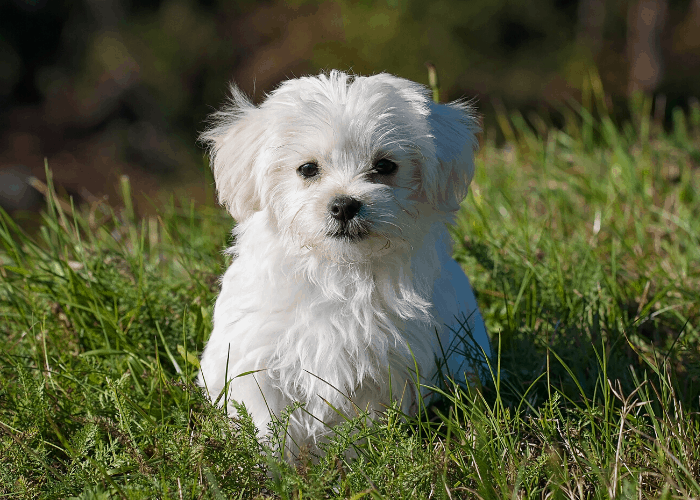
The Italian Maltese is known for its lively and playful temperament, which was bred into it as a companion dog.
They love being around people, and even aging Maltese will still love to play with their owners. They’re known to form very strong emotional bonds with their families.
Italian Maltese can sometimes be snappy or grumpy, which isn’t considered a fault in the breed.
However, this can be worked around with proper training from a young age. This can also help to provide the breed with mental stimulation, which is equally important.
Although not the most energetic breed, Italian Maltese do still need daily walks.
However, they don’t need to be very long, as 30 minutes should be fine. Combining this with playtime will help give the dog a happy and fulfilling life.
[table id=74 /]Related Questions:
1. How much do Maltese puppies cost?
Maltese dogs have always been pricey, and you could expect to pay up to 10,000 USD for a Maltese pedigree puppy! However, the normal price is around 1500 USD.
2. Do Maltese dogs bark a lot?
Maltese dogs are known to bark a lot, regardless of what’s happening. What’s more, it can be almost impossible to train this trait out of them.
3. Can Maltese dogs be left alone?-
Maltese dogs like human attention, but can be left alone for up to 8 hours if trained properly. However, this should be worked on from a young age.
13. LAGOTTO ROMAGNOLO
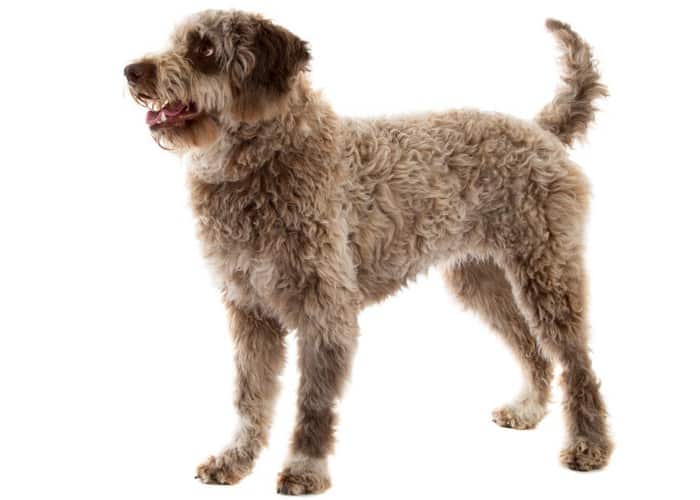
Highlights: Keen, Friendly, Loving
The Lagotto Romagnolo is a breed of gun dog that comes from the region of Romagna in Italy.
It was traditionally used as a water retriever but is now also used for hunting truffles because of its amazing sense of smell.
Lagotti have tight curly coats that don’t shed. This means the Lagotto Romagnolo is considered a hypoallergenic dog breed.
Their coat is very dense and woolly, which was designed to keep them warm while in the water. Any color coat is accepted, apart from black.
The breed is relatively new, but the first recorded Lagotto Romagnolo is in a painting from the 15th century.
Also, it’s believed that many modern water retrieving breeds descend from the Lagottti.
Lagottis are still regularly used as working dogs, particularly for truffle hunting.
However, they’re becoming popular as a family pet thanks to their friendly temperament and loving demeanor.
That said, they’re still relatively unknown outside of Italy, mainly because other similar breeds have received more attention.
The Lagotto Romagnolo is perfect for hunting truffles because it has an incredible sense of smell.
This also means it’s regularly used as a search and rescue dog too, although this is considered its secondary purpose.
Did You Know?
- The Lagotto Romagnolo is the only dog breed in the world that’s used for truffle hunting.
- It’s also believed to be the original water dog and is the ancestor of all modern water breeds.
- Its name comes from “lago”, which is the Italian word for the lake.
Temperament
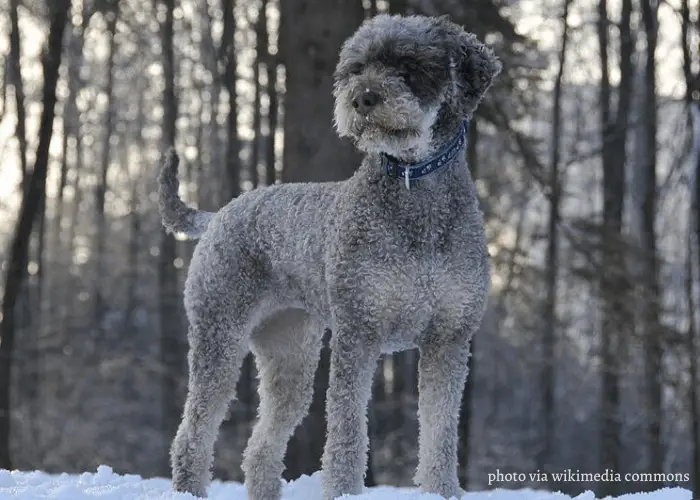
Lagotto Romagnolo is a very alert and active breed that’s known to have very sharp senses.
Along with an amazing sense of smell, it’s also known to have keen eyesight and excellent hearing. This is why they’re so popular as retrieving and truffle hunting dogs.
However, they’re also known to be very loyal and affectionate towards their owners, which is why they’re such good family pets.
Proper socialization is vital, though, because the breed is very energetic, which can be difficult to control around small children.
On that note, exercise is incredibly important for proper development for Lagotti.
The breed’s working nature means they have plenty of stamina, so daily walking is a must. Also, this needs to be combined with training and mental stimulation to stop the dog from getting bored.
Lagotti are naturally very strong swimmers but also love to dig. Owners are encouraged to provide the dog with a sandbox, as this helps to channel its need to dig without it being too destructive.
[table id=75 /]Related Questions:
1. How much does a Lagotto Romagnolo cost?
For a pedigree Lagotto Romagnolo, you can expect to pay up to 7000 USD. However, the average cost is around 2500 USD.
2. Do Lagotto Romagnolo smell?
Although their coat is thick and dense, it doesn’t hold smell like some other breeds. The Lagotto Romagnolo isn’t known to really smell at all.
3. Do Lagotto Romagnolo bark a lot?
Lagotto Romagnolo can bark a lot, but this can be controlled with training. If not worked on, however, it can become a problem.
It’s not too late to see more beautiful European Dog Breeds from the countries below:
CONCLUSION:
Many of the top Italian dog breeds aren’t too well known outside of Italy. However, the ones that are making up some of the most popular dog breeds in the world.
Hopefully, this list has shown you that there are plenty of interesting dog breeds to come out of Italy, some of which have been very influential on other breeds.
REFERENCES: ✍️
1. [^] Korec, Evžen, et al. “Longevity of Cane Corso Italiano Dog Breed and Its Relationship with Hair Colour.” Open Veterinary Journal, Faculty of Veterinary Medicine, University of Tripoli and Libyan Authority for Research, Science and Technology, 2017, https://www.ncbi.nlm.nih.gov/pmc/articles/PMC5475242/.
2. [^] De Risio, L, et al. “Idiopathic Epilepsy in the Italian Spinone in the United Kingdom: Prevalence, Clinical Characteristics, and Predictors of Survival and Seizure Remission.” Journal of Veterinary Internal Medicine, John Wiley and Sons Inc., 2015, https://www.ncbi.nlm.nih.gov/pmc/articles/PMC4895410/.
3.[^] Guandalini, Adolfo, et al. “Epidemiology of Ocular Disorders Presumed to Be Inherited in Three Large Italian Dog Breeds in Italy.” Veterinary Ophthalmology, U.S. National Library of Medicine, Sept. 2017, https://www.ncbi.nlm.nih.gov/pubmed/27860098.

